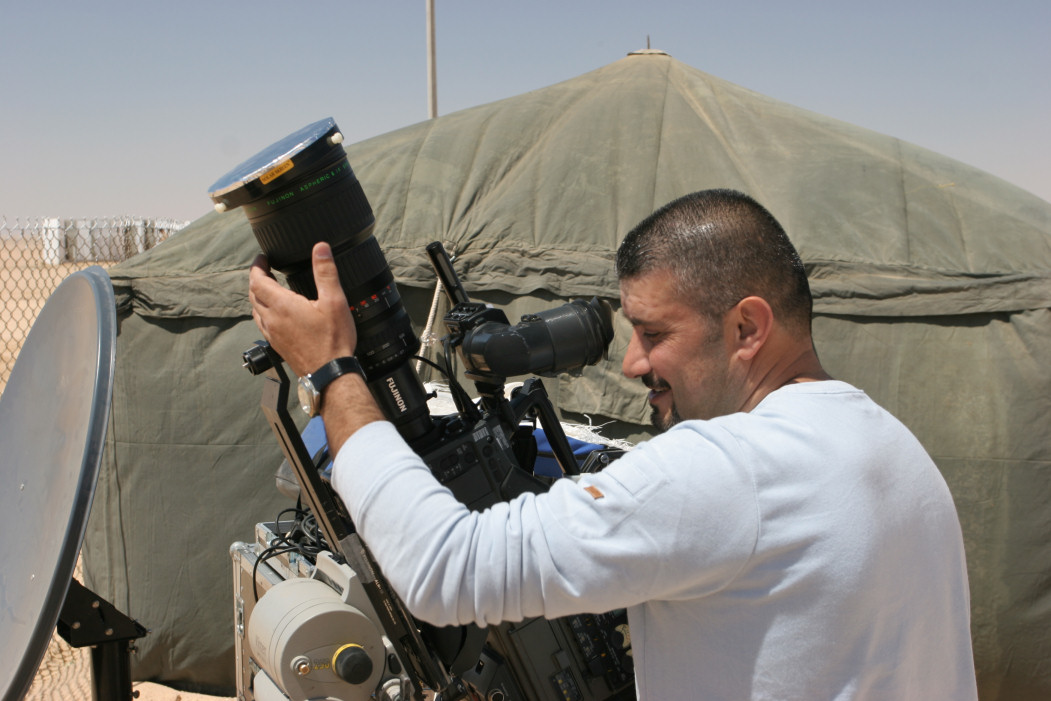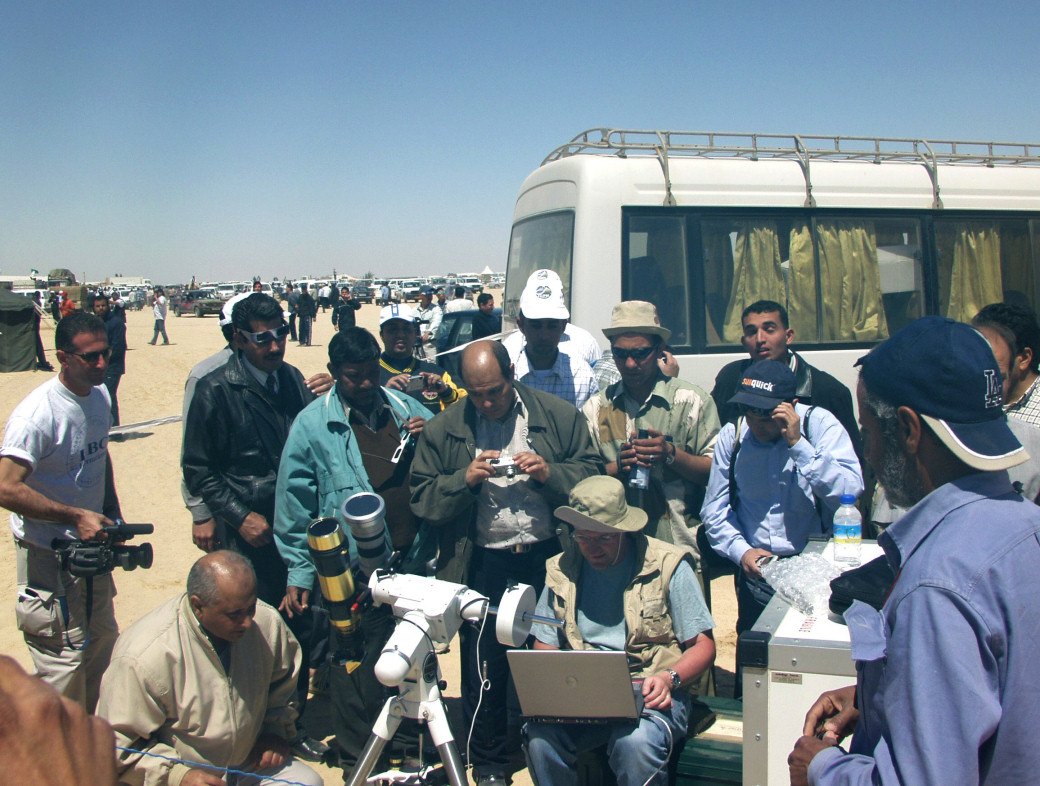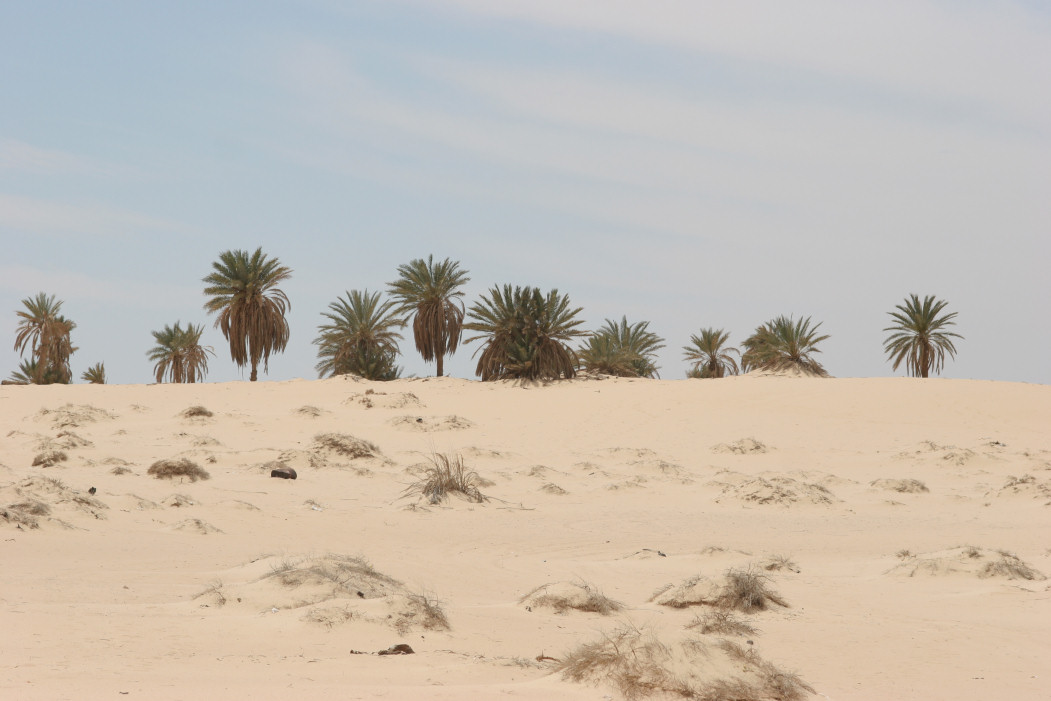
The March 2006 total solar eclipse seemed to be an event not to miss because of its closeness to Europe. I saw my last Total Solar Eclipse in 1999.
I had the opportunity to be invited by Libyan Center for Remote Sensing and Space Science (LCRSSS) for watching this event.
The eclipse location selected was the one "nearby" Benghazi, the city hosting LCRSSS Astronomical dept. Jalu is the closest city.
Red spot indicates Total Solar Eclipse observation place, where we have been.

Libyan government have installed a campground to gather all the eclipse watcher at the same location, this avoids the risk of having people spread out throughout the desert. The famous Eclipse tax has been well spent : it went to set up this kind of very impressive campground.
The desert at this location is thoroughly flat, hostile and extremely warm during the day (>30°C). The nights are quickly cold, the temperature went down to 8°C.
The camp was located few kilometers from the main road going from Jalu to Kufra, and army controlled.
More than 10.000 people was excepted to attend the eclipse. A lot of people coming from United States was there (surprising fact knowing the past history between the two countries !).
Also lot of Japanese people.

This place altitude is about 120m and lot of oil fields can be noticed from the main road during the trip. The soil was sandy, similar to one you can have in a standard south Atlantic French beach, nearby Spain, no grass and no trees around !

Endless sea of Sand ! People setting up a tent nearby the campground.

We came there a day before to prepare the whole setup, and align the polar mount.
Some seeing measurement with a DIMM have been carried out during the previous night, and showed 0.7 to 1 arcsec ! Amazing figures...
To avoid the effects of dust coming from people stepping around, a truck went at the observation place to spill out water !! Impressive how the libyan people wanted this place as much organized as possible ! Nevertheless, the low elevation, the sand dust/storms and aerosol makes this place not suitable for regular astronomical observations despite a good seeing. We hope the mountain in south Libya to be as good as this place !

Sunset before the TSE Day ! Some helicopters from the Army were there, in case someone beeing seriously sick to be evacuated.

Journalists and people from LBC Channel, to broadcast the event ! We advise them how to proceed during the total phase (i.e to remove the filter, for instance !)

The equipment used was a CANON EOS 20D combined with a EF 300mm F4L. The 300 mm lens is a very good and sharp lens. The sun's or moon's size is 2.6mm at the detector level, ie 390 pixels. The field of view was 4.2° x 2.9°.
The image scale is 4.6 arcsec per pixel

15 minutes before totality, crowd is increasing, as well as operator stress !
The Solarmax Coronado 60mm and the EQ5 mount were lend to me by the Benghazi Dept. of Astronomy.
The EQ5 allowed me to record long exposures images (up to 2 sec) also, to keep the moon/sun at the same location with respect to the digital camera field.

The author during the event !! The sun is really hard here....
Partial phase starts :
15 minutes before totality

The EOS 20D digital camera (DLSR) was set to ISO 100 and tied to a PC laptop and PRISM software. It allowed me to watch the Eclipse without taking care of the DLSR camer (pressing any button or operating the camera).
During totality a PGM PRISM script was running (here is the script used), allowing to capture automatically 46 exposures, at exposures times from 1/8000 to 2s. All images were acquired using the DLSR RAW mode.
One image each 6s has been recorded, along the 4min and 3sec total phase. This is due to the fast readout of the DSLR CMOS detector and the RAW image saved to the internal DLSR Compact flash Card Memory.
The RAW mode allow better image processing and the recording of full 12 bit resolution images (instead of 8).
"To" is the date of the second contact.
Eclipse beginning : 1/8000sec, at To + 5s

Eclipse beginning : 1/4000sec, at To + 11s

Eclipse beginning : 1/2000sec, at To + 17s

Eclipse beginning : 1/500sec, at To + 34s

Eclipse end : 1/125sec, at To + 3m42s (20s before end, chromosphere starts to be visible)

Eclipse End : 1/250 sec (To + 4:00 min) 3rd contact is close to occur !!

Composite corona image, visual impression when using 10x50 binoculars.
Made of 1/125s + 1/60s + 1s image combined.
The huge corona gradient has been removed by the means of a mathematical model. (Lot of work!) Stars are visible, up to magnitude 8.
Next image : an image processing with the moon embedded from long exposure images from the totality, the moon's earthshine was visible when exposures times was larger than 1/2s.
Moon and Sun at the same scale (Image Editing), sun 2 hours before totality...note the Moon is slightly larger, of course, allowing 4 minutes of Totality. The moon travels the sky at a speed of 1/2 degree per hour !

The sun has been recorded with a 10.000x filter

Here above a 1s exposure image processed to enhance the Moon in front of the Sun, as seen in the raw image below

Image showing a faint moon and stars in Pisces, no bright star are visible in this field.
Moon exit at To + 4m36s, no filter 1/4000s

A tiny part of the sun, as seen in the next image, is "killing" the previous image ! Here the exposure time is 1/4000sec, ie 250µs, the next image is equivalent to an unfiltered 50ns exposure time (1/20 000 000 sec) !
Moon exit at To + 4m42s, with filter 1/2000s, photosphere is visible

This goes to the end ...... the moon goes away !

A desert's view ... while coming back to Benghazi

Palm trees (oasis) close to Jalu

This is the end....
I wish to thank :